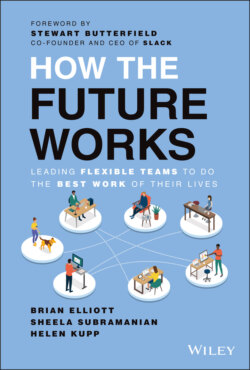Читать книгу How the Future Works - Brian Elliott - Страница 17
3) Build Better Results
ОглавлениеBecause it has a positive effect on common business challenges, like recruiting and retention; because it leads to happier, less stressed, and more engaged employees; because of these things and more, flexible work, when done right, quite simply drives better business results.
And yet leaders regularly have concerns. One of the most common ones is that flexible work will negatively impact productivity. Some version of the following question comes up often: “If my team members aren't in the office, how will I know that they're working?” The question itself is problematic because it calls to mind the kind of outdated, Industrial-Era mindset, focused on monitoring and presenteeism, that we discussed in the last chapter. We'll talk more about what is effective in Step 7, but what's important to know now is that the concern isn't backed up by data. In fact, research shows just the opposite: flexible work actually increases productivity. And, it's important to note, while location flexibility is beneficial, schedule flexibility yields even better results: a more than 30% increase in reported productivity.11
One example of productivity gains can be seen in Professor Prithwiraj Choudhury's study of the US Patent and Trademark Office (USPTO) as they made the switch to a more flexible work model. He and his colleagues found a 4.4% boost in individual productivity in terms of the organization's key metric for success—the number of patents examined each month. Contrary to expectations, quality of work didn't suffer with the switch, but employee engagement rose considerably. In 2013, a year after the new policy took effect, USPTO topped the list of Best Places to Work in the Federal Government.12
Customer engagement can be positively impacted as well. At Slack, team members found that connecting remotely made it easier to meet with more customers during the day, as well as get time on an executive's calendar since videoconferencing often felt less formal than an in-person meet. Where they used to be able to visit one client a day, sales staff say they can now do three videoconferences in a day. Salesforce found similar benefits: Their Zoom customer calls had 25% higher C-level attendance and their sales teams reported getting back two weeks of selling time due to their virtual sales kickoff taking up less time on their calendars than previous in-person ones.
Another way that flexibility builds better results is by enabling diversity, which, as is now well-known, has a positive impact on results. There are numerous studies that support this, including one done by Boston Consulting Group in 2017 that linked diversity and profitability: Companies with above-average diversity among their executive teams saw EBIT (Earnings Before Interest and Taxes) margins that were 9 percentage points higher than those who were below average. Even more striking, those same companies reported innovation revenue that was 19 percentage points higher than that of companies with below-average leadership diversity—45% of total revenue versus just 26%.13 Diverse companies also tend to grow faster, be more innovative and adaptable, have higher cash flow, and even be better at building leaders.14
In spite of the great potential of diverse organizations, especially in solving today's most complex problems, many leaders struggle with the friction that comes with diverse teams. Flexible work, while not a total solution, is a tool that can help for a variety of reasons. For one, about 60% of the Black labor force in the US is located in the Southeast, compared to only one-third of private sector jobs.15 Location flexibility allows companies to attract employees who live far from their offices. We have already seen how this benefited Dropbox, who saw a 16% increase in diverse candidates. As a result of the transition to flexible work, Slack has hired one-third more remote-based historically discriminated employees than office-based.
Future Forum research shows that large majorities of Black, Hispanic, and Asian respondents in the US all want flexible work—which means it can have a positive impact on recruiting and retention among these groups. The same is true for women, and we have already talked about some of the benefits to working moms and other caregivers who are disproportionately female. Flexible work can also offer a better experience to groups that have been historically discriminated against. For example, Black employees who work remotely have a higher sense of belonging than those who work in the office.16 There are likely a variety of reasons for this. As Stanford professor, Brian Lowery, explains, office-centric work can perpetuate outsider status: “Black employees can experience stress associated with working in a predominantly white workplace, which contributes to a lower sense of belonging. Importantly, it might not be work activities per se driving these effects, but all of the big and small social interactions that make up much of our work days.”17
Finally, it's worth noting the impact flexible work can have on your bottom line. Retaining employees saves companies money. Increasing productivity makes companies more money. Decreasing the need for costly expenditures on things like office buildings in expensive urban centers and travel to and from different client and company locales frees up resources that can be put to better use elsewhere—on those things that will drive the outcomes you want. Think of it this way: Would you rather invest money in the seats your employees occupy or in the things that will enable those employees to do their best work, no matter where they sit?
